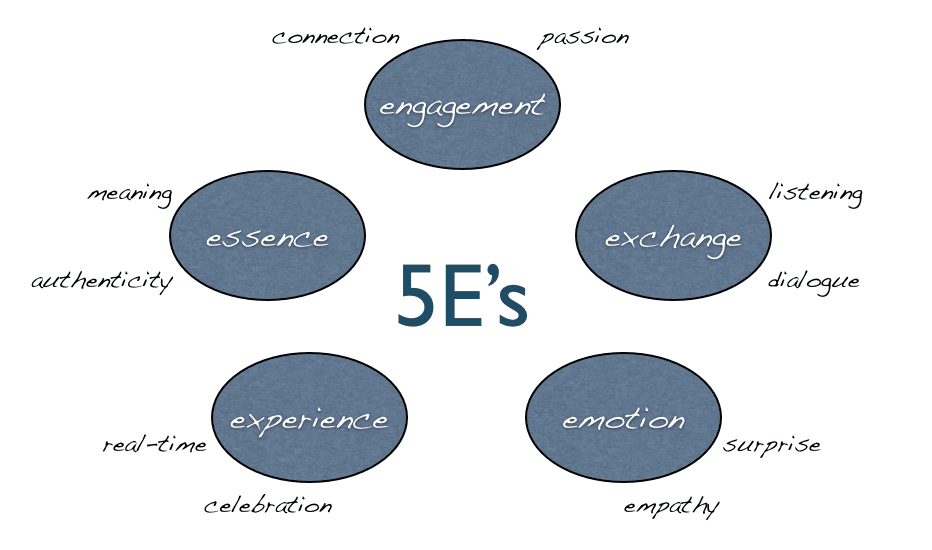Successful branding and marketing is no longer about selling a product at the right price, in the right place with the right advertising and promotions. A brand should express a personality, a sense of meaning, and, sometimes, even a sense of humor. In order to gain traction, messages from the brand should create a feeling, a reaction that encourages discussion and sharing. All points of contact with the customer can be beneficial to the brand; because they can help the company on new product development, adjusting pricing and reconfigure promotions… In some cases, customers can provide their own best customer service as demonstrated by Apple. The marketing principle of the 4 P’s (product, price, publicity, place/distribution) — invented in the 1960s — is outdated and must yield in importance to the marketing of what we have called the 5E’s of marketing: Engagement, Exchange, Emotion, Experience, & Essence.
The marketing of the 5 E’s is holistic, incorporating three stages: before, during and after the act of buying. As such, marketing becomes everyone’s business. All the stakeholders – internal and external to the company, such as distributors, suppliers, employees, shareholders and customers – become communicators of the brand. The brand is no longer confined to the marketing department. In this new mode, brands often need to adopt a new mindset in its internal and external communications, which means making regular micro-adjustments to the positioning and letting go of total control. Enter the role of a Brand Coach.
The concept of coaching a brand was born in the USA. Initially, however, the definition has been limited to the role of a ”sell-out manager” (dealing with the sell through). In this case, coaching as a concept is used inappropriately. A coach should work to support — not to replace — the actors of the brand. The brand identity is expressed and felt by the consumer throughout all points of contact. The brand’s values should be embodied, as much as possible by all stakeholders. A coach, in this context, is to help a CEO to represent the brand and ensure that the expression and experience are “infused” at all levels to ultimately be passed on to consumers who become increasingly involved in the brand. Of course, the consumer was previously able to participate through word of mouth. However, today the message reaches many more people faster, and, especially, through multiple sources. Just as the spider weaves its web, brand coaching is accomplished in a multi-directional, interactive, dynamic and complex environment.
Among the difficulties faced by companies, there is the question of surveilling and listening to ”stakeholders” on the web. Who does what? How is the information conveyed? What is the best response in case of a crisis on the web? Who knows what? Who is in charge? In short, a litany of unanswered questions inside most enterprises.
In a world that is flattening (cf Thomas Friedman’s The World is Flat), a company’s resources – such as the call center – are becoming increasingly limited; offshore outsourcing has become second nature. Thus, the consistency and coherence of the customer experience, as well as staff’s commitment and enthusiasm – particularly true for global brands – are real issues.
Brand coaching is a vast subject, which cannot be limited to a sub-contractor at the point of sale experience. The Brand Coach is designed to explain and decode the customer de facto experience. In this context, the company should try to make its business practices and communication more transparent. This does not mean total transparency or full body nudity; but, there is a need for some form of consistency between what is said and what is done. In any case, the employee’s sense of belonging and trust in the company are crucial to achieve – and exceed – customer expectations and the company’s revenues.
In seeking a successful and sustainable brand, the employee – particularly he/she of the “Generation Y” ilk – must live and believe in the values of the company. The examples are numerous as to the relevancy of this point. Compare the traveler’s experience on Cathay Pacific or Singapore Airlines where the flight crew provides dedicated and careful service, versus the passenger’s experience “as a number” traveling on American Airlines or Delta Airlines.
Brand coaching is a matter of men and women. It is to help the company navigate through all channels of communication and help find a voice / channel. What message to communicate, what audience or community, and by what means? Furthermore, brand coaching requires the full commitment of the CEO to provide the vision and reaffirm the message on a daily basis. The Brand Coach is to accompany and help transform the vision into reality. If direct communication — “private label media” as described by Egoli, Moeller and Vollmer in Strategy & Business – can be facilitated in part by the “tool” of the Internet, nothing can replace the experience, efficiency and emotion of a team empowered by a strong and consistent
—————–
This article was first published in English on a specific site created by Tiffany and myself. You can also find it in French here.












Stumbled upon this blog. Will be keen to read more!